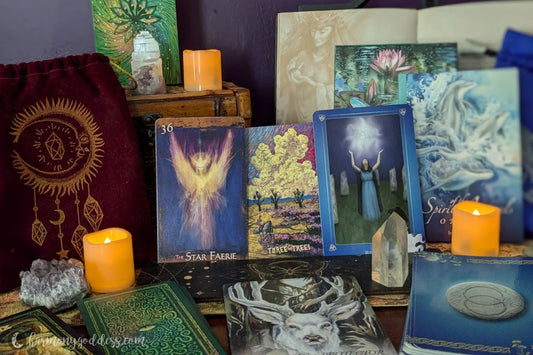Exploring the Sun Goddess through Myth
When we look at the Goddess that modern pagans work with, we talk about meeting under a full moon, and drawing down the moon. In this way many groups are taught to see the divine feminine in the night sky among the stars. That sense of mystery, and the phases She goes through ARE truly magical, but Lady Luna is not the only Goddess that ancient cultures saw when they looked up to the sky.
In truth, there are many cultures that had prominent sun goddesses who were revered as powerful, life-giving forces tied to the sun's vital role. Let’s start with a culture that resides in the northernmost reaches of Earth, The Norse.
Sunna the Norse Sun Goddess
Sol/Sunna was the Norse sun goddess who rode a chariot pulled by horses across the sky, bringing the sun. Sol/Sunna is described as the daughter Mundifari, and is known for her great beauty. Driving the Chariot that pulls the sun, Sol runs across the sky to escape the wolf that chases her. There are times when the wolf catches the Sun, and that is when there is a solar eclipse. But because Sunna has healing powers, she is able to heal the Sun and bring back the light to the world.

And as we know, the Sun and Moon are related, so Sol/Sunna an important counterpart to her brother Mani, the moon god. So sister and brother roam across the sky day and night, providing light for humanity.
So from the North, let’s travel to the far East to Japan. And this Goddess of the sun is not only one of the most revered Shinto deities, but also the mythical ancestress of the imperial family.
Amaterasu the Japanese Sun Goddess
The mythology of Amaterasu tells us that She was held in the highest esteem by the ancient people of Japan, and was considered the chi ef kami (deity) of the Shinto pantheon. Stories of Amaterasu and her siblings, who are known as the “Three Precious Children” are found in Japan’s earliest literary texts (c 712 CE) and are truly wonderful for those who love a deep dive into mythology.
ef kami (deity) of the Shinto pantheon. Stories of Amaterasu and her siblings, who are known as the “Three Precious Children” are found in Japan’s earliest literary texts (c 712 CE) and are truly wonderful for those who love a deep dive into mythology.
Not only is Amaterasu one of the most well documented Goddesses, but She has been continuously revered for millenia.
In fact according to wikipedia:
“Amaterasu's chief place of worship, the Grand Shrine of Ise in Ise, Mie Prefecture, is one of Shinto's holiest sites and a major pilgrimage center and tourist spot”
Japan is so far East that it is known as the “Land of the rising sun”, whose flag flies as a testament to the Goddess even in the present day.

The Sun Goddess Around the World
When you start looking for the Sun Goddess, you begin to find Her influence all around the world. Sun worship was extremely prevalent in ancient Egypt. And while many people may have heard of the Sun God Ra (aka Re), what isn’t as well known is that several female deities pre-dated His worship. Egyptian Sun Goddesses include Hathor, the Mother of Re, and Re’s daughter Sekhmet who is known as the Eye of Re because she fiercely defends her father.
In the Hittite religion, Arinna/Hebat was one of the three major solar deities and the most important sun goddess. Later she was assimilated by the Syrians as the sun goddess Shapash.
Also on my home continent, several Indigenous American cultures had prominent sun goddesses like Unelanuhi (Cherokee), Malina (Inuit), and He'-koo-lās (Miwok).
When I first connected to the Goddess as a force of nature in my visionary artwork, it’s no wonder that it all began with the Sun Goddess. Without Her light and warmth, there would be no life on this planet. So when the day dawns or the Sun sets, remember Her many names which were, and better yet still are, known and honored around the world.
Here are some resources if you would like to learn more about the Sun Goddess:








